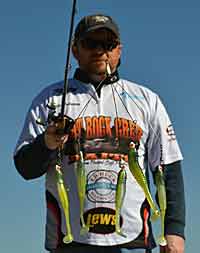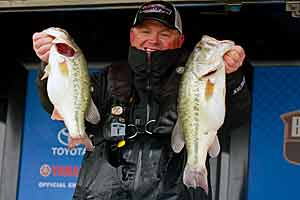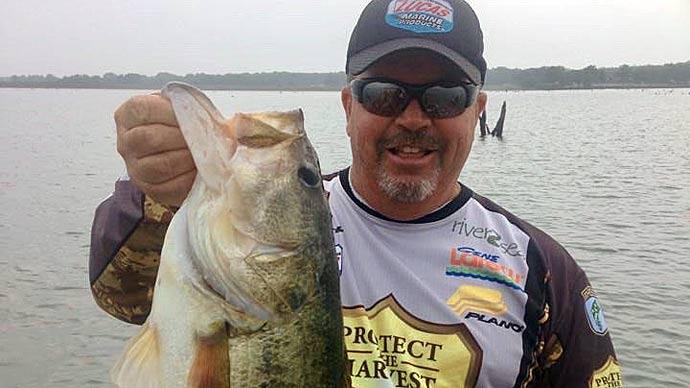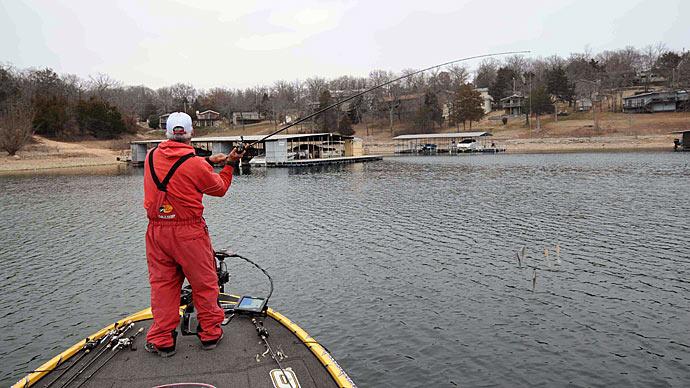
It was a late winter day that felt more like spring. Warm sunshine poured from above, and a slight breeze worked ripples from the main lake toward the back of this cove. It took many minutes to rig up my new Alabama rig. I carefully threaded five swimbaits on five jig heads, then attached one to each of five wire arms. It only took a few to witness its power. The rod loaded up on the second cast to a rounded point halfway in the cove. It felt weird, the fish pulling then turning into dead weight. I had doubled up on the A-rig at the boat, and much to my surprise. It was the first trip I threw it, and the first fish I caught on it ended up being two. I’ve thrown it on some trips and set it aside on others since that day. And while it continues to produces bass – some anglers say better than any lure ever has – it also continues to produce controversy.
The A-rig made its first splash in 2011. That’s when Laurel, Miss., pro Paul Elias, better known for dropping to his knees to get the most from his deep-diving crankbaits, used it to win the FLW Tour Open on Lake Guntersville in Alabama. He fished it around bridge abutments and ended the tournament with more than 102 pounds, distancing himself from second by about 17 pounds. The waves from that tournament are still roiling the bass tournament world. Elias and others showed how easily bass could be caught with an A-rig, which caused panic and wonderment in anglers worldwide. It was called the perfect lure, one that could consistently catch more and bigger bass than any lure that came before it. The thing is, its principle wasn’t new. Similar rigs had been trolled by saltwater anglers and those fishing for freshwater stripers for years. The A-rig was “new” because it was a downsized version that could be cast with conventional bass tackle. But all the catching it was doing caused panic. Some anglers said the A-rig was so simple and effective that its use would erode well-honed skills and growing bass populations, carefully reared in a culture of almost mandatory catch and release. The fact that the five-baits-at-one-time idea was quickly applied to jigs, crankbaits, and even topwaters only helped their case. In three short years, the A-rig has had a powerful effect on the sport. Concerning its most common five-wire form, here are five ways that it has done so:
Changing the rules
Elias’ boat was probably still wet with Guntersville water when anglers began picking sides. The discussion – how to handle A-rigs in tournaments – is sometimes heated. B.A.S.S. was the first to line up against it, at least at its top level. The original tournament organization, which returned to Guntersville this spring for its Bassmaster Classic, banned the A-rig from its Elite Series and Classic starting in 2012. However, it green-lighted it in its other events, including the Bassmaster Opens, where it is still permitted today.

FLW, while still enjoying the attention generated by Elias’ performance, took a wait-and-see stance and allowed its competitors to continue to fish A-rigs. Some FLW anglers, including Pennsylvanian Dave Lefebre, came out against its use, saying it flew in the face of the one-rod, one-bait skills that tournaments were supposed to test. Lefebre and others refused to use it. When the 2012 FLW Tour kicked off, armchair anglers predicted that every tournament's top finisher would be fishing it. While it made some strong showings in the first few events, it quietly slipped to the background as the Tour moved into the summer.
Overriding every tournament are state regulations. Regarding the A-rig, they ranged from wide open to overly restrictive. Anglers traveling to events that allowed A-rigs still have to check to see if they are permitted in that state or even that body of water, and if so, are there any restrictions such as hooks or lures. Always the innovators, anglers found ways to adapt A-rigs to meet the regulations without giving up much of their fish-catching power. If the rules require fewer than five hooks, for example, A-rigs with two or three wires are used, or attractor swimbaits – without hooks – are run on as many wires as needed. Chris Martin won the FLW Tour stop on Tennessee’s Lake Chickamauga in 2013. He threw a modified A-rig that had three baits with hooks and ten attractors. It looked like a chandelier, some observers said.
FLW adjusted its A-rig rules for the 2014 season. It’s not entirely lights out for it, but its power might not be as bright. “FLW has thoughtfully studied the use of umbrella rigs for two seasons, and we’ve decided to no longer permit their use on the FLW Tour,” said FLW President of Operations Kathy Fennel in a press release. “The rigs have evolved, so we can no longer wait for state-enforced restrictions to be developed. That said, umbrella rigs will be permitted in our other tournament circuits, but with restrictions that limit them to a maximum of five wires outfitted with a maximum of five spinners and five lures, only three of which can have hooks. This decision is consistent with the wishes of a majority of our anglers while heading off potential conservation concerns.”
Changing competition

Shane Lineberger agrees with Fennell’s last point. He feels that when one bass is hooked on an A-rig, the other baits can bite into it during the battle and cause it harm. The Lincolnton, N.C., tournament angler is a past BFL All-American qualifier and is fishing the Bassmaster Northern and Southern Opens in 2014, along with a smattering of local events on Lake Norman and other Carolina lakes. During his travels, he fished many lakes and threw many lures. That includes the A-rig. “It’s OK for fun,” he said. “It’s good for the sport, but not for tournaments. I throw it when I have to, but I don’t like it.”
At the 2013 Southern Open on Douglas Lake in Tennessee, Lineberger threw an A-rig on the first day and boxed 24 pounds and 6 ounces, enough to take the lead. But many of his competitors also threw it, and he finished 17th. “If you look at the weights, the top 30 was all about 18 pounds [on day one], give or take,” Lineberger said. “And 95 percent were throwing the A-rig.” It has leveled the tournament fishing field, especially during colder months when bass are balled up and biting baitfish away from the bank. The A-rig is simple to use – heaving it out is probably the most challenging part because of its weight and bulk. He says anglers need to figure out the depth the bass are holding, count the A-rig down to them and start winding. “Five casts, and you can win the tournament,” he said. “It makes the things I learned over the years a moot point. There’s no need to learn how to fish a jig or jerkbait in the winter.” At least that's true when you can throw an A-rig.
Changing catches
Lineberger said fishing an A-rig is about targeting schools, not individual fish like when you are flipping down a bank. Its reputation for catching multiple bass on one cast helped put it in the doghouse with some anglers. “The main thing it has taught me is how the fish relate to cover and structure during the winter,” he said. He’s found it works best in colder water until it warms to 55 or 60 degrees. Water that cold had been a security blanket for bass. Slow fishing during that timeframe used to keep many anglers at home. The A-rig makes those bass, which had been inaccessible to most anglers for a long time, catchable. “The bad thing is, winter bass used to get a break,” Lineberger says. “Now 25 to 30 fish days, all coming on the A-rig, are common. And it catches the biggest fish in the lake.”
Changing perspectives
If there is one thing that A-rigs have taught anglers, it is that bass aren’t as shy as they thought. Five big swimbaits spread out by a wire harness that’s towed by 65-pound test braided line moves a lot of water and presents a formidable profile. But bass – little-to-big – come right up and blast it, often in groups. That reaction has opened Lineberger’s eyes. It’s made him unafraid to rig up a variety of colors of swimbaits. “Orange, yellow – all sorts of craziness,” he said. The A-rig also has caused him to fish single swimbaits more. He used one to finish 14th in the 2012 Bassmaster Southern Open on Smith Lake in Alabama. Sometimes he rigs 5-inch swimbaits Texas-style, but during others, such as this event, he downsizes to 3- or 4-inch models. He fishes those on 6- or 8-pound test line, slowly swimming them through schools of bass in the fall.
Changing the future
Will the A-rig bring more changes to bass tournaments and fishing in general? Has enough time passed for its place in fishing history to be cemented? Probably not. It’s still evolving. Lure manufacturers, for example, have introduced smaller versions for panfish and a plethora of new swimbaits. Lineberger said he has noticed some fall off in its potency, but he chalks that up to the same phenomenon that affects every hot lure: bass become conditioned and avoid them. Anglers will still grab A-rigs, though. They’ve been conditioned to throw them because of their effectiveness.




